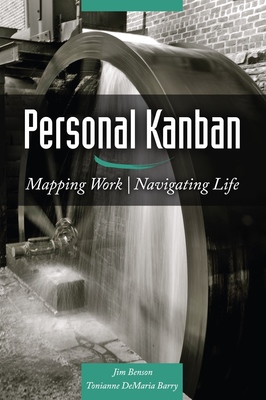Personal Kanban
Mapping Work, Navigating Life
Personal Kanban is a lightweight, flexible productivity system for individuals. It helps a person manage their various activities including work, personal projects, errands, and recurring tasks. It is very easy to get started with.
Personal Kanban helps you become more effective and reduces your stress levels, by visualizing your work so you can see it at a glance, and by helping you avoid taking on too many things at once.
The book makes it clear that we should be aiming for effectiveness, not productivity. In other words: focus on getting things done, rather than keeping yourself busy.
Personal Kanban asks that we do two things:
-
Visualize your work. At any time you should be able to look at your overall workload, get a sense of priorities, and quickly determine what you should work on next. It should be easy to reorganize as new things come up or priorities change. By seeing tasks you have already completed recently, you get a sense of accomplishment.
-
Limit your work in progress (WIP). In other words, limit the number of things you work on at the same time. It encourages you to finish what you are already working on, before you start working on something new.
While it seems deceptively simple on the surface, Personal Kanban is rooted in real psychology and observations about how people are wired.
There is an existential overhead to having a bunch of to-dos in your head, which causes stress. By capturing them all in one place and visualizing them, this existential overhead is reduced.
Visualizing your work and regularly interacting with it in a tactile way helps your brain to notice patterns and make observations. Then this allows you to make improvements to the process itself and how you work. For example, you may think "wow I have a lot going on, maybe I shouldn't take on that new project right now". Or you may noitice "new stuff keeps coming up but I keep neglecting all those tasks related to my business, maybe I need to spend some time on that".
The system is typically implemented using a whiteboard, some whiteboard markers, and sticky notes. It is not a highly prescriptive process; rather it is a general lightweight framework that can be customized to suit your particular needs. In a way, it is a process that helps you improve your process.
I heard about Personal Kanban by way of a conversation with Marcus Hammarberg at a conference. I have been struggling to balance the many things going on in my life, including work, family, physical fitness, a couple of side businesses, this website, daily personal development, home improvements, plus regular errands like gardening and mowing the lawn. While I had my own way of managing and prioritising tasks for major projects, each of these projects was managed separately, and I had no single unified view of everything going on in my life.
I started reading this book one morning, and by later that morning I had set up my own Personal Kanban system on a whiteboard in my office and had a backlog of tasks up there. It has now been a little over a week and I have made various tweaks and adjustments, and I am loving it.
I really like Personal Kanban for the following reasons:
- It is really easy to get started with.
- It can be customized to my liking.
- It is easy to experiment with.
- It adds very little overhead to my day.
- Getting all my tasks written down in one place felt like a burden lifted off my shoulders.
- Being able to visualize my work in one place allows me to make better decisions about priorities, whether to take on new work, and so on.
- It helps me remember and stay focused on what I wanted to achieve today, instead of aimlessly wandering between different tasks or procrastinating.
- It encourages me to finish what I started, rather than leaving a bunch of tasks half finished and beginning new ones.
- Seeing what I've accomplished recently makes me feel good.
If you struggle to manage tasks between various areas of your life, give Personal Kanban a try.
